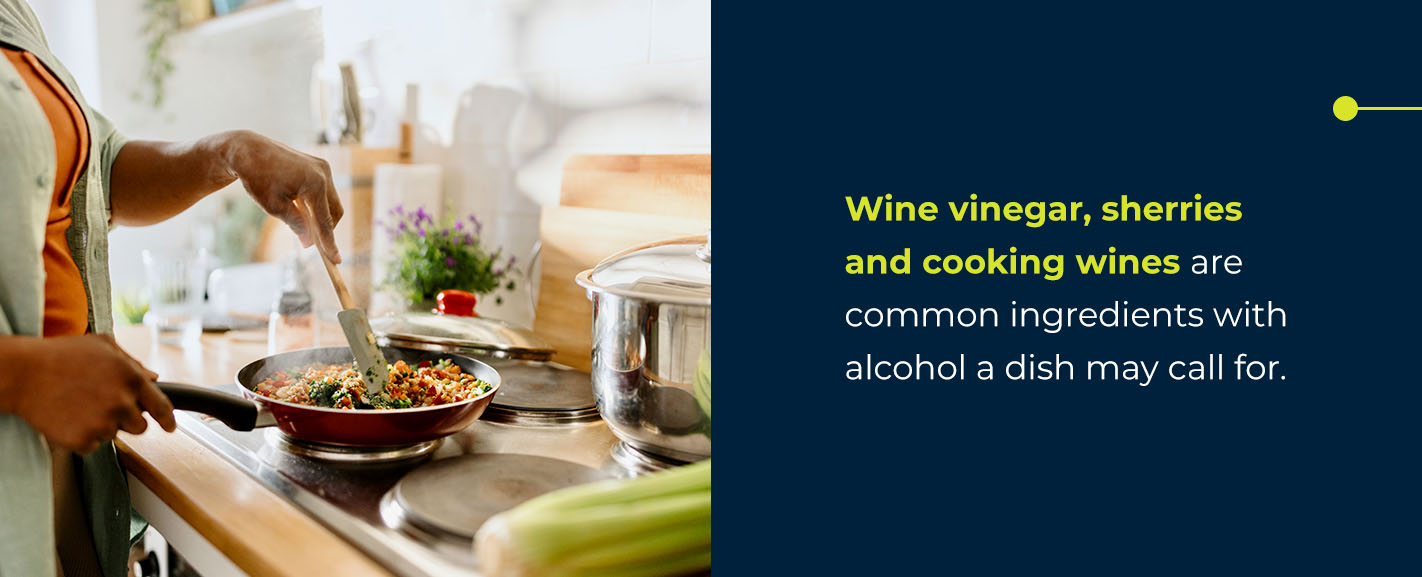- Feb 4
- AddictionDrug Addiction Treatment
From pasta sauces to chocolates, alcohol is an increasingly popular ingredient in many foods, drinks and consumables. With consumables gaining popularity, many people recovering from an alcohol dependency may wonder if it is safe to consume food or beverages that contain small amounts of alcohol. While many people may think those with an alcohol dependency are only concerned with alcoholic drinks, alcohol consumables can also jeopardize a person’s recovery process.
- What Are Alcoholic Consumables?
- Examples of Alcoholic Consumables
- The Dangers of Alcoholic Consumables
- Regulations Surrounding Alcoholic Consumables
- Alcohol Addiction Treatment at the Gateway Foundation
What Are Alcoholic Consumables?
Alcoholic consumables are food or drink products that contain trace amounts of alcohol. You will see consumable alcohol in everyday food items, such as ice creams, gelatins, candies and more. In some cases, there may be hidden alcohol in products, and a consumer may not realize it. While it may seem minor to most consumers, hidden alcohol in food can trigger those recovering from an alcohol dependency.
While some may think these products are not common, many major brands use bourbon, wine or whiskey flavoring in their items.
In some cases, alcohol may even be a hidden ingredient in a consumable that may not be as apparent or easy to identity without reading the ingredients label. While it may be obvious that a bourbon-flavored snack may have alcoholic ingredients, there are many unassuming or unexpected food products that surprisingly contain some level of alcohol.
Examples of Alcoholic Consumables
Alcohol is a common ingredient in many dishes and food. While many say the alcohol gets cooked off when the food is heated and prepared, even consumables with a very small level of alcohol can trigger those recovering from an alcohol dependency. While the total alcohol content in food may be low, it’s generally recommended to avoid these consumables, as even the flavor or aroma can increase the risk of potential relapse.
Even slight fermentation or a negligible alcohol content can bring back strong memories of alcohol, making it a difficult experience for some people to not act on these memories. It is important to learn which foods and drinks may contain even trace amounts of alcohol to decide if you should avoid these consumables. Some of the most common examples of alcohol-infused foods and drinks include:
- Desserts: There are many fresh and packaged desserts that may have alcohol as an ingredient. Some of the most popular alcoholic desserts include cherries jubilee, tiramisu, bananas foster and many dessert compotes and glazes. There are also champagne or wine-flavored jellies, jams and custards, which also contain alcohol.
- Cooking ingredients: All wine vinegar, as the name implies, contains certain amounts of alcohol. Additionally, cooking wines and sherries are also common ingredients a dish may call for, containing alcohol. Some bearnaise, pasta, bordelaise and barbecue sauces may also contain alcohol.
- Candies: Liquor and alcohol-flavored chocolates and candies are very popular alcohol consumables. These sweat treats often contain traces of alcohol to give the candy flavoring. Examples of alcoholic consumable candies include liquor or champagne-filled chocolates or champagne-infused gummy bears.
- Drinks: While the name may be misleading, non-alcoholic wines and beers actually contain trace amounts of alcohol. Additionally, kombucha is a popular drink that also contains small amounts of alcohol due to fermentation.
- Fresh dishes: Many fresh and packaged cheese may contain alcohol, including port wine cheese. In many cases, cheese fondues may also have alcohol. Fresh dishes, such as penne alla vodka or chicken marsala, are also made with alcohol.
The Dangers of Alcoholic Consumables
Alcohol is a common ingredient in cooking and one that finds its way into many of your drinks and food. While you may not think much of a negligible amount of alcohol in your food, it can be dangerous for those recovering from alcohol addiction.
While alcoholic consumables may not be as strong as drinking a cocktail, they can still be harmful to those recovering from an alcohol dependency and can increase the risk of relapse or other addictive behavior.
Alcoholic consumables have trace amounts of alcohol in them, but the amount varies. The alcohol retention rate depends on the type of alcohol and the cooking method used. If a consumable is not heated or cooked, then the alcohol content is not affected or reduced. Certain cooking methods, like torching, don’t remove the full alcohol content despite the high heat.
Alcoholic consumables pose numerous risks for those in active addiction or recovery, including:
- Increases relapse risk: Even if there is a negligible amount of alcohol in a consumable, it can still invoke strong memories for those in alcohol dependency recovery. For many, the recovery process is ongoing, and an alcoholic consumable can disrupt this progress. If someone ingests an alcoholic consumable, it can increase the risk of relapse.
- Jeopardizes recovery: An alcoholic consumable can trigger strong memories of previous alcohol consumption, affecting the recovery process. These strong memories associated with taste and smell may lead some people to experience difficulties and struggle during the recovery process.
- Normalizes alcohol consumption: Alcoholic consumables also normalize alcohol consumption, even on a small scale. When consumers find alcohol in everyday products, like ice cream and candy, it can make it difficult for those in alcohol dependency recovery to get avoid seeing these products.
- Creates challenging situations: Many people recovering from an alcohol dependency may have difficulty around snacks or meals that contain alcohol. Someone without an alcohol dependency may not realize how triggering or difficult it is for someone working through recovery to be in a situation where alcoholic consumables are available.
Regulations Surrounding Alcoholic Consumables
As alcohol becomes a more common ingredient in many types of food, there has been much talk about potential regulations surrounding these consumables. One of the most notable alcohol in food laws is House Bill 11. The state House Committee on Alcoholic Beverage Control (ABC) presented this bill to regulated alcoholic consumables.
House Bill 11 argues that the sale and regulation of alcoholic consumables with at least 0.5% alcohol by volume must fall under the control of the ABC. Under this bill, alcoholic consumables are treated similarly to alcoholic drinks, with consumables containing wine or beer for sale where traditional wine and beer are available. Additionally, these alcoholic consumables would be taxed as alcoholic drinks.
Alcohol Addiction Treatment at the Gateway Foundation
Consumable alcohol products can be difficult to identify, but with the help of experts who are there for you for life, you can avoid these consumables and stay on the path to recovery.
The Gateway Foundation is a leading provider of evidence-based treatments. We are proud to offer alcohol addiction treatments, drug addiction treatments and co-occurring and dual diagnosis services. Our team includes highly educated and well-respected medical and clinical professionals and expert psychiatrists. We approach each patient with the highest level of compassion and expertise. Learn more about our addiction treatment services and contact us online today or call (877) 381-6538.




